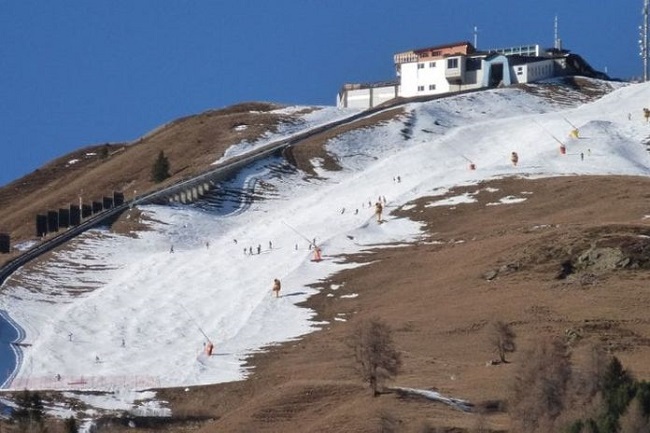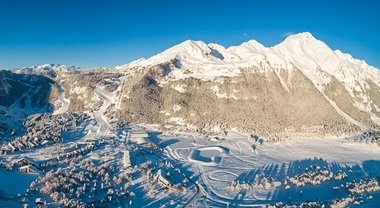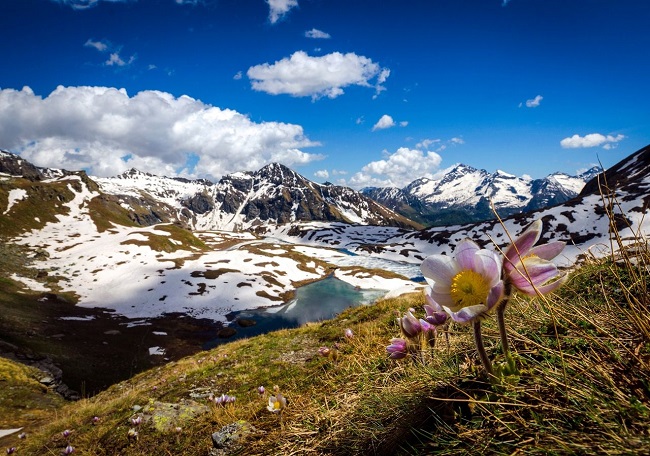Nell’ultimo secolo la durata del manto nevoso si è accorciata di oltre un mese: lo attesta uno studio scientifico condotto da un team di ricercatori dell’Università di Padova e dell’Istituto di scienze dell’atmosfera e del clima del Consiglio nazionale delle ricerche di Bologna. La ricerca è pubblicata su «Nature Climate Change»
La neve sta diventando sempre più effimera nelle nostre Alpi. Nonostante la tipica variabilità che conosciamo bene tra un inverno e il successivo, quello che stiamo sperimentando negli ultimi decenni è qualcosa che non si era mai riscontrato da prima della scoperta delle Americhe. In pratica, nell’ultimo secolo la durata del manto nevoso si è accorciata di oltre un mese.
Questo quanto emerge dall’articolo Recent waning snowpack in the Alps is unprecedented in the last six centuries appena pubblicato sulla prestigiosa rivista «Nature Climate Change», frutto della collaborazione di un team di ricercatori dell’Università di Padova e dell’Istituto di scienze dell’atmosfera e del clima (Isac) del Consiglio nazionale delle ricerche di Bologna coordinato dal prof. Marco Carrer del Dipartimento Territorio e Sistemi AgroForestali di Padova.
«Abbiamo scoperto che un arbusto estremamente diffuso, il ginepro comune, quando si trova in alta quota ha un portamento strisciante sul terreno, ovvero cresce orizzontalmente molto vicino al suolo, ed è in grado di registrare nei suoi anelli di accrescimento la durata della copertura nevosa – dice il prof Marco Carrer, ecologo forestale dell’Università di Padova e primo autore dello studio -. Infatti, essendo alto poche decine di centimetri, la sua stagione di crescita dipende fortemente da quanto precocemente riesce ad emergere dalla coltre bianca che lo ricopre.»
«Per lo studio dei cambiamenti climatici è necessario disporre di un’ampia prospettiva temporale. Purtroppo le informazioni riguardanti il manto nevoso vengono generalmente raccolte solamente da pochi decenni – spiega il dottor Michele Brunetti del Cnr-Isac -. Da qui la necessità di guardare oltre l’orizzonte fornito dai dati strumentali e trovare altre fonti che ci permettano di estendere a ritroso nel tempo le informazioni climatiche necessarie.»
«Incrociando le misure degli anelli di accrescimento del ginepro, che può raggiungere età considerevoli (oltre 400 anni), con un modello di permanenza del manto nevoso elaborato ad hoc, siamo riusciti a ricostruire le condizioni di innevamento negli ultimi sei secoli. Ciò ci ha permesso di comprendere che quello che stiamo vivendo negli ultimi anni è qualcosa che non si era mai presentato precedentemente» concludono i due ricercatori.
È la prima volta che si riescono ad ottenere informazioni su un così lungo orizzonte temporale per questa variabile meteorologica estremamente importante. La neve ha infatti un ruolo chiave nel bilancio energetico terrestre, ma è anche fondamentale per i sistemi naturali, sociali ed economici della regione alpina che si sostengono grazie alla sua disponibilità. Dovremmo, infatti, acquisire maggiore consapevolezza delle nuove sfide dettate dai mutamenti in atto e futuri per una regione i cui equilibri si sono mostrati fortemente sensibili ai cambiamenti climatici.
In the last century, the duration of the snowpack has been shortened by more than a month: this is attested by a scientific study conducted by a team of researchers from the University of Padua and the Institute of Atmospheric and Climate Sciences of the National Research Council of Bologna. The research is published in ‘Nature Climate Change’
Snow is becoming increasingly ephemeral in our Alps. Despite the typical variability that we know well between one winter and the next, what we are experiencing in recent decades is something that has not been seen since before the discovery of the Americas. In practice, in the last century, the duration of the snowpack has been shortened by more than a month.
 This is what emerges from the article Recent waning snowpack in the Alps is unprecedented in the last six centuries, just published in the prestigious journal “Nature Climate Change”, the result of the collaboration of a team of researchers from the University of Padua and the Institute of Atmospheric and Climate Sciences (Isac) of the National Research Council of Bologna coordinated by prof. Marco Carrer of the Department of Territory and AgroForestry Systems of Padua.
This is what emerges from the article Recent waning snowpack in the Alps is unprecedented in the last six centuries, just published in the prestigious journal “Nature Climate Change”, the result of the collaboration of a team of researchers from the University of Padua and the Institute of Atmospheric and Climate Sciences (Isac) of the National Research Council of Bologna coordinated by prof. Marco Carrer of the Department of Territory and AgroForestry Systems of Padua.
“We discovered that an extremely widespread shrub, the common juniper, when it is at high altitude has a creeping habit on the ground, that is, it grows horizontally very close to the ground, and is able to record in its growth rings the duration of snow cover – says Prof. Marco Carrer, a forest ecologist at the University of Padua and first author of the study -. In fact, being a few tens of centimeters tall, its growing season depends strongly on how early it manages to emerge from the white blanket that covers it.”
“Studying climate change requires a broad time perspective. Unfortunately, information regarding the snowpack has generally been collected only for a few decades – explains Dr. Michele Brunetti of the Cnr-Isac -. Hence the need to look beyond the horizon provided by instrumental data and find other sources that allow us to extend the necessary climate information back in time.”
“By crossing the measurements of the growth rings of juniper, which can reach considerable ages (over 400 years), with a model of permanence of the snow cover developed ad hoc, we were able to reconstruct the snow conditions in the last six centuries. This allowed us to understand that what we are experiencing in recent years is something that had never occurred before» conclude the two researchers.
It is the first time that information has been obtained over such a long temporal horizon for this extremely important meteorological variable. Snow plays a key role in the Earth’s energy balance, but it is also fundamental for the natural, social and economic systems of the Alpine region that are sustained by its availability. We should, in fact, become more aware of the new challenges dictated by the changes taking place and the future of a region whose balances have shown themselves to be highly sensitive to climate change.





